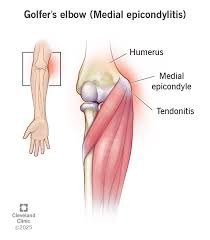Managing Elbow Pain
What are Tennis Elbow and Golfer’s Elbow?
Tennis elbow (lateral epicondylitis) and golfer's elbow (medial epicondylitis) are common forms of elbow pain caused by overuse or repetitive strain of forearm muscles and tendons. These can also both be caused by tearing or blunt trauma to these tissues.
Common Presentations
Tennis Elbow
Pain and tenderness on the outer (lateral) side of the elbow
Pain worsened by gripping, lifting, or repetitive wrist and arm movements
Golfer's Elbow
Pain and tenderness on the inner (medial) side of the elbow
Pain exacerbated by gripping, lifting, or wrist flexion movements
Common Causes
Repetitive wrist and forearm movements (e.g., sports, typing, manual labour)
Poor technique in sports or repetitive tasks
Insufficient conditioning or muscle strength in the forearm
Aging and tendon degeneration
Prognosis
Both conditions typically improve with conservative management within 6-12 months. Early intervention promotes faster recovery and reduces the risk of chronic symptoms.
Assessing Tennis Elbow and Golfer’s Elbow
Clinical assessment typically includes:
Detailed patient history to identify specific activities contributing to symptoms
Physical examination, including provocative tests to confirm diagnosis
Imaging (ultrasound or MRI) if indicated to assess tendon health and exclude other conditions
Evidence-Based Management
Recommended clinical management includes:
Exercise Therapy: Strengthening and stretching exercises to improve forearm function and reduce strain
Manual Therapy: Techniques such as massage, mobilisation, and myofascial release to relieve pain and improve mobility
Activity Modification: Adjusting or temporarily ceasing activities that provoke symptoms
Pain Management: Short-term analgesics or anti-inflammatory medications as per clinical guidelines
Supportive Devices: Bracing or taping to relieve tendon stress
Additional Treatments: Shockwave therapy or injections in persistent cases, following clinical recommendations




